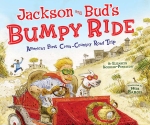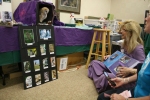A week ago, my husband and I took a couple of days and drove to Santa Cruz, one of our favorite towns to wander about communing with sea lions and pelicans, eating clam chowder at Stagnaro Brothers, and people-watching throughout this wonderful community. The locals here were able to support their fabulous independent bookstore, Bookshop Santa Cruz and close the large chain one who moved in to close them. Hurrah Santa Cruz!
We stayed in a motel we often visited when our son was young, but we hadn’t been there in years. Away from the bustling crowds at the beach, the motel is quiet, not outrageously expensive or especially classy, but it suits our needs just fine.
Settling into the room, I began unpacking, but paused as I heard my husband chuckling.
“Liz, take a look at this,” he said, gesturing to our surroundings.
The left side of the room had been painted maroon with blood-red flowers stenciled along the top near the ceiling. A print hung near the desk with matching colors; the bedding corresponded too. But the sliding glass door’s curtain shouted bold green, along with its wall. I swear I heard loud screeching in my ears just like I did whenever I walked by a middle school band room during a practice session.
“So the question is, did they forget or run out of money?” I asked as we laughed at the look the decorator achieved.
When you think you are finished with your writing, it might only be half done. Set it aside for a while. Your eyes have grown accustomed to seeing it and you might miss those big, bold errors that are glaring to everyone else. Later, read it aloud to yourself. Print out the pages for revision. A paper copy is tangible and real. After that make your computer corrections.
Do you have too much narration? This technique works best for your less dramatic scenes. When it’s emotionally important, slow-down-the-moment with your senses with action, reaction, thoughts and dialogue.
Highlight your favorite parts of your manuscript. Why are they your favorites?
Analyze the rest of your piece to discover how you can make this writing as resonant as your best, favorite parts.
Don’t over-use tags. If it is clear who is talking, you may not need to say “he said,”“she said.”
Do you have “pet” words? If certain words come up over and over again, get rid of them!
If you were reading this in published book or magazine, what questions would you have? Critique it as a reader, not as you, the author. This is where the “giving it time” will help you. If you’re still too close to it and can’t revise, call in a trusted colleague or pay for a professional editor to help you.
And finally this from George V. Higgins from On Writing: “Reading your work aloud, even silently, is the most astonishingly easy and reliable method that there is for achieving economy in prose, efficiency of description, and narrative effect as well. Rely upon it; if you can read it aloud to yourself without wincing, you have probably gotten it right.”
Writing Prompts:
- Revise one of your older manuscripts you THOUGHT was already perfect. How can you make it better?
- Meet with another writer and revise the other person’s manuscript. Share some of your favorite revision tips.
- Write something new inspired by this time of year. Look around you for ideas. The first object you see outside – – the first word or photo in the newspaper – – the first page in a book you open that is near you can be a prompt for a story. Write as many drafts as you need on your computer and then print it out. Revise with a pencil and then go back to the computer for another draft. Did printing it out help you find more ways to improve your writing?
************
For those of you children’s book lovers, here is a great link for you:
The Kirkus List of Best 100 Books for Children of This Year
https://www.kirkusreviews.com/issue/2012-best-of/section/children/=


 Zoie
Zoie